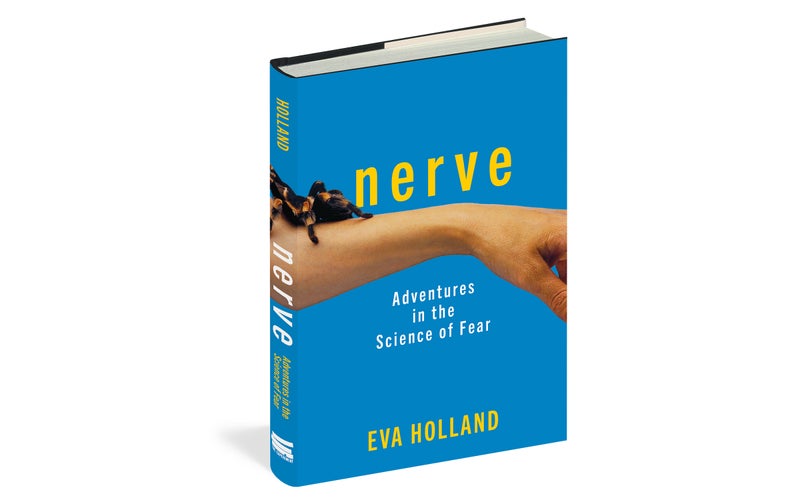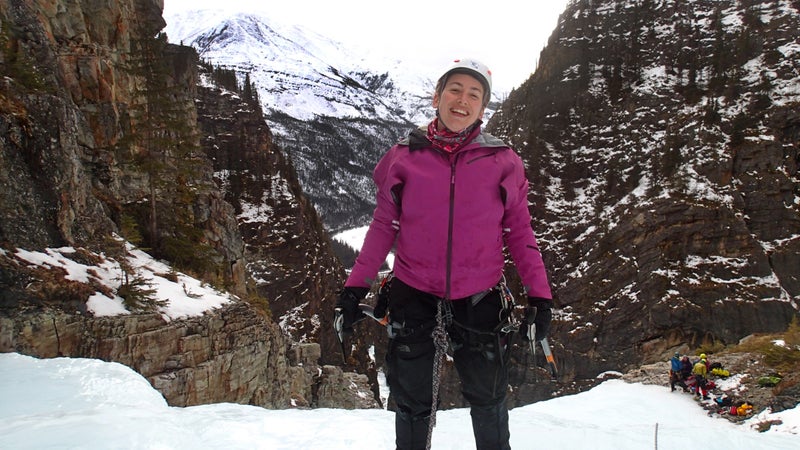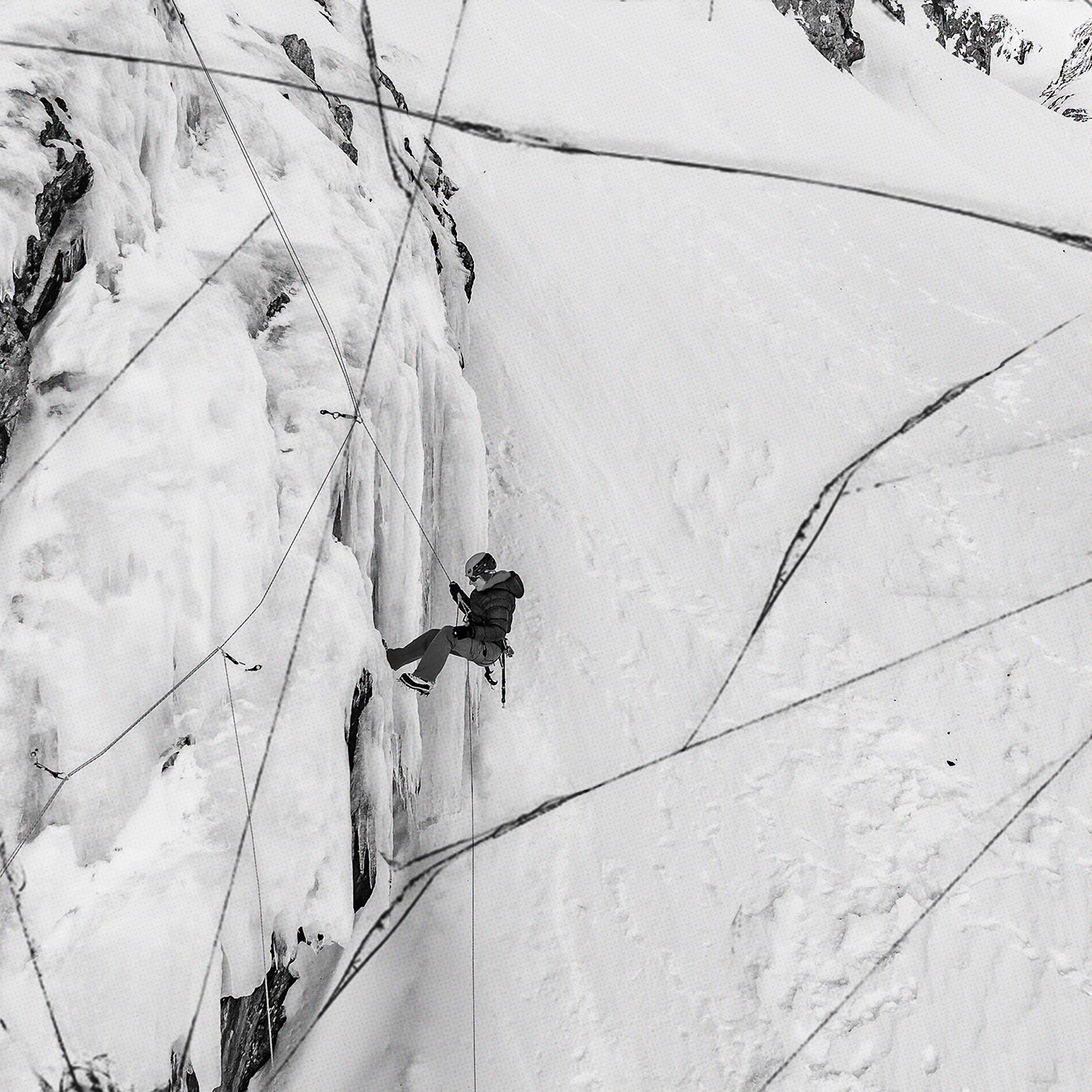We started the day with strong coffee and a short drive south on the Alaska Highway from a remote lodge to an even emptier stretch of snowy pavement. As the dark February day grew lighter, we laced up heavy ice-climbing boots, buckled on packs loaded with ropes and gear and food and water, and began our ascent into the mountains.
It was February 2016, and our group of a dozen or so had come from our home in Whitehorse, the small capital city of the Yukon, a few hours away, for an extended weekend of ice climbing in far northern British Columbia. My friends Ryan and Carrie and their crew of climbing pals had been making this trip annually for several years. This was my first time tagging along.
Ryan and Carrie are natural teachers and leaders, people who genuinely enjoy passing on their skills and knowledge to others, and for the past few winters, they had been making occasional efforts to teach me how to ice climb: to ascend frozen waterfalls using crampons, axes, and rope. I was a poor student. I liked the thunk of my ax┬ásinking solidly into thick ice, the soreness in my shoulders and calves as I moved up a route, step by step. I loved the glow of satisfaction when I reached the top of a climb. But I was afraid of heightsÔÇöspecifically, I was afraid of falling from exposed heights. Climbing, then, was hard for me. Ryan and Carrie have both seen me cry, more than once. TheyÔÇÖve┬áheard me beg to be allowed back down to the ground; theyÔÇÖve┬áheard me announce, loud and flat and on the verge of losing control, that I was ÔÇťnot having fun anymore.ÔÇŁ
I kept at it because, some of the time at least, I was having funÔÇöand because I wanted to learn to master my fear. But my progress had been slow, and this winter I hardly climbed at all. My mom had died suddenly the previous summer, and I largely let sports and socializing slip away in the months afterward.
It was about an hourÔÇÖs uphill hike, alongside a creek bed through the snow, before we paused to strap on our crampons and then carried on up the frozen creek itself, the steel spikes offering us traction. The creek rose in slow increments: an easy step up, then a flat surface for a few steps, then a longer step up, and so on. Sometimes an icy rise would be too much to clear in a single step, and weÔÇÖd kick the toe spikes of our crampons into its sloped surface and climb up that way.

Eventually we came to the true start of the climb, a route known as the Usual. One by one, we tied a rope to our harnesses and then ascended the first short wall. After that came another, longer section of steep climbing, and then another.
It was a beautiful day, sunny and clear, with the temperature hovering around freezing. I was nervous, as usualÔÇöespecially since there were members of the group that I barely knew. I was always even more mortified to show my fear in front of strangers. But I was handling the climbing just fine, with no tears or pleas for mercy. I was even managing, as I sometimes did, to enjoy it.
When I made it to the top, I popped out onto an open, frozen plateau with a sweeping view all the way back to the highway. I took a selfie with the vista behind me and then sat down in the sun to eat my lunch, feeling proud and satisfied.
Around 2:00, Carrie found me and suggested that I be one of the first to start making my way back down. I would likely be among the slowest. I agreed. Descending involved a series of rappels: tying in to a secured rope and then lowering myself by hand down the ice walls.
I had never tried rappelling. The gang had taught me the basics the night before, in the hotel. They hitched me to a rope tied to a post in the hallway, and I walked backward across the linoleum, feeding the rope through my harness as I went. Of course, that lesson had taken place on a horizontal surface.
Still, I was feeling good, feeling ready. Carrie got me set up, and I steeled myself to walk backward off the edge of the plateau and down the icy face of my most recent climb.
I loved the glow of satisfaction when I reached the top of a climb. But I was afraid of heightsÔÇöspecifically, I was afraid of falling from exposed heights.
The first rappel went well. I was able to laugh after I lost my balance, failed to brace myself with feet wide, and swung sideways into the ice. The second one was okay too. The third was trickier: I had to make my way along a curving tunnel of ice, and again I lost my footing and swung hard into an ice wall, dangling helplessly on the rope, banging my elbows and knees. I swung and fell again as I neared the bottom of that rappel, and I slid down the rope and landed in a heap, the ice axes IÔÇÖd hung on my harness digging hard into my sides.
Now I was embarrassed and in pain. I had a quick little cry there, tangled in my gear at the bottom of the rope, and then I picked myself up and moved out of the way so someone else could follow me down.
I struggled through two more short rappels, but my mood had become grim, and my control only deteriorated further as I descended. The afternoon was cooling off as sunset approached, and all that swinging and slamming had soaked me with water from the sun melting the ice through the day. I was cold, hungry, and exhausted. I was not having fun anymore. At the bottom of the last rappel, I sat down off to one side, away from the others, and cried, trying to hide my face. I ate a Snickers bar IÔÇÖd been savingÔÇöchocolate almost never fails to cheer me upÔÇöbut it only helped a little. We still had a long way to go to reach the cars.

When everyone had arrived at the bottom of the last rappel, we bunched together to head down the walkable, unroped portion of the route, along the frozen creek. As the group began to head down in twos and threes, I stood on the edge of one of the low ice bulges IÔÇÖd stepped up without difficulty that morning. There was maybe a foot, a foot and a half, between the flat surface I stood on and the next flat section of ice. All I had to do was reach out with my boot and step down. I stared at my feet, but I couldnÔÇÖt make them move. I kept picturing myself stepping down and my crampons failing to catch in the ice, my foot flying forward like IÔÇÖd stepped on a banana peel in a cartoon. From there, I watched my body collapse, slide down the first ice bump and then the next, picking up speed, sliding and sliding down every frozen rise, all the way to the bottom. I couldnÔÇÖt do it, said a voice in my head. I would fall. I would die.
Some irrational force had taken over my body. I couldnÔÇÖt breathe properly, couldnÔÇÖt move my limbs. A tiny part of me knew I just needed to take one step down, that everything would be fine if I could only move my feet, but that voice of reason had been shoved into a corner at the back of my brain. Another voice was in control now.
Ryan noticed my distress and circled back to reassure me. I heard myself tell him that I couldnÔÇÖt come down the mountain, unfortunately. The group would just have to leave me there, I said. I couldnÔÇÖt walk down, so they would all have to go on. I would stay right where I was.
My flat tone said my plan was reasonable. But staying where I was, as the temperature plunged and darkness came on and I stood shivering in my wet Gore-Tex, would be suicide. Still, my feet refused to move. I watched Ryan confer with the others and send Carrie and the rest of the group on ahead so they could make it to the cars before dark. Ryan, his friend Joel, and a third guy I barely knew, Nic, stayed behind.
Joel stood on one side of me and grabbed my left hand. Nic took hold of my right. Ryan stepped down to the next ledge and turned to face me, pointing with his ice ax┬áat the spot where I needed to put my foot. Slowly, taking deep breaths and clutching JoelÔÇÖs and NicÔÇÖs hands hard, I forced my right foot down. My crampons caught. I did not slide to my death. Then we repeated the process with my left foot.
The light dimmed, and the night got cold. We inched down the mountain, Ryan pointing out every step, promising me that it was safe. Right foot. Left foot. I think I cried quietly, some of the time, from fear and frustration at the extent to which my body and mind had betrayed me. I was still halfway convinced that if I took one wrong step, it would be the step that killed me. It felt like the descent took hours. Eventually we pulled out our headlamps and carried on downhill in the dark.
Once we made it off the ice and onto the snowy trail for the last part of the hike down, I was finally able to let go of JoelÔÇÖs and NicÔÇÖs hands. We tramped to the highway mostly in silence, and my fear receded enough for me to wonder how angry they were. Did Ryan wish heÔÇÖd never invited me on this trip? Surely he must have. By the time we were in the car, the four of us piled into the single remaining vehicle, my lingering fear had been eclipsed by the most powerful feeling of humiliation I have ever experienced. I sat in the back seat, trying to shrink into nothing, unable even to enjoy RyanÔÇÖs traditional post-climb bag of dill pickleÔÇôflavored potato chips. I was utterly mortified.
The light dimmed, and the night got cold. We inched down the mountain, Ryan pointing out every step, promising me that it was safe.
Back at the hotel, I did the best I could. I forced myself to socialize with the group over cards and drinks instead of hiding myself away. I offered beers to the guys whoÔÇÖd peeled me off the mountain. At some point, I asked Ryan what he would have done if I hadnÔÇÖt voluntarily taken that first downward step. ÔÇťYou wouldnÔÇÖt have liked it,ÔÇŁ he said. I had a vision of Ryan and Joel hog-tying me and dragging me down the frozen creek, bump by bump, in a slow-motion version of my imagined death-by-sliding. He was right. I wouldnÔÇÖt have liked it.
The next day, when the rest of the group went climbing again, I stayed at the hotel. I went for a long run along the highway. I read a book. I tried to relax and enjoy my weekend, tried to appreciate the blue sky and the white mountains all around the lodge. But I kept thinking back to my behavior the day before.
It was unacceptable, I decided. IÔÇÖd tried half-heartedly to work on my fear of heights over the years, but the matter never seemed urgent. I had never before put my own life, and the safety of others, in danger because of it. I could hardly believe the lunatic on the mountain had been me, declaring that I would die from exposure rather than walk down a frozen creek. What was the matter with me?
I tried not to let myself dwell on it, but my collapse on the Usual was a setback when I had only just begun to put myself together again. For much of my life, I feared my momÔÇÖs death. Her own mother died when she was a child, and growing up, I had become intimately aware of the devastation the loss had left in its wake. I dreaded living through the same loss, and when my turn did come, I fell apart. In the months after, I retreated completely from my life: from friends, from exercise, from the things I normally did to challenge and amuse myself. For too long, I felt like I had forgotten how to smile or laugh, like the muscles in my face had stiffened up and no longer knew how to perform those simple acts.
It had only been a few weeks since IÔÇÖd started to reengage socially. I had started running, started feeding myself properly again, stopped living on my couch in a blur of binge-watched TV shows.
I didnÔÇÖt want my setback on the mountain to derail my slow, hard-earned return to normal life. I didnÔÇÖt want my terror to control me that way ever again. I decided, sitting alone in that hotel by the side of a lonely highway, that I would figure out what had happened in my brain on the mountain that day. And then, I decided, I would figure out how to fix it.
Excerpted from Nerve: ║┌┴¤│ď╣¤═°s in the Science of Fear ┬ę 2020 by Eva Holland. Reprinted with permission of .╠ř


